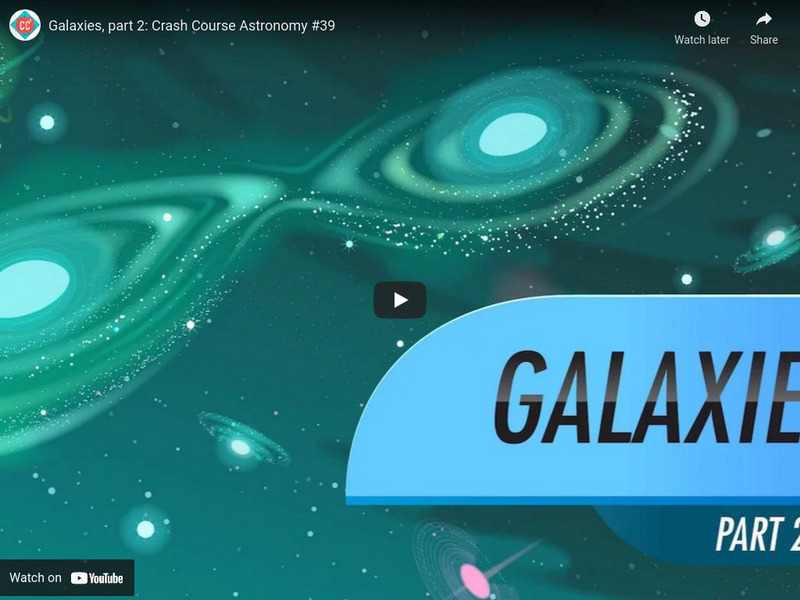NASA
Hubble Trivia: 16) What has Hubble helped reveal about Jupiter’s Great Red Spot?
The Hubble Space Telescope has been revealing the secrets of the universe for over 30 years, but it turns out Hubble has some secrets of its own! The question is: What has Hubble helped reveal about Jupiter’s Great Red Spot? You might be...
Curated Video
Telescopes: Time Machines into the Distant Past
This video explains how telescopes can act as time machines, allowing us to see objects in space as they appeared millions of years ago. By measuring distances in light years and understanding the speed of light, scientists can observe...
NASA
Hubble's Scary New Halloween Image
NASA’s Hubble Space Telescope has unveiled a spooky new image staring out from the depths of the cosmos. The new image reveals the twin galaxies AM 2026-424 — a pair of interacting galaxies that may foreshadow our Milky Way’s own...
NASA
New Hubble Video Miniseries Goes Behind the Scenes of Our 'Eye in the Sky'
A new video miniseries explores the intricate world of operating the Hubble Space Telescope. In Hubble – Eye in the Sky, viewers get an inside look at the challenges of operating the telescope, along with an understanding of the...
NASA
Hubble’s 30th Year in Orbit
On April 24, 2020, the Hubble Space Telescope celebrated its 30th year in orbit by premiering a never-before-seen view of two stunning nebulas named NGC 2020 and NGC 2014. Even after all these years, Hubble continues to uncover the...
Curated Video
Choque de galaxias: Andrómeda y la Vía Láctea
¡Choca esos cinco millones de estrellas!
Astrum
How can Hubble see distant galaxies clearly, but not Pluto?
Hubble has taken some spectacular images of many different galaxies, but it can't resolve more than a few blobs on Pluto's surface. Why is that?
NASA
NASA | JWST Feature - Colliding Galaxies
Deep surveys by the James Webb Space Telescope will capture the full panorama of galaxy evolution, from the earliest dwarf galaxies that formed to the familiar galaxies we see today. The Webb Telescope will help us understand how the...
Curated Video
Exploring the Past: The Fascinating Concept of Light Years
In this video, we explore the concept of how telescopes allow us to see objects that are light years away, giving us a glimpse into the past. By understanding how light reflects off objects and travels to our eyes, we can comprehend how...
NASA
Hubble Trivia: 8) When Was the Last Space Shuttle Servicing Mission to Hubble?
The Hubble Space Telescope has been revealing the secrets of the universe for over 30 years, but it turns out Hubble has some secrets of its own! The question is: When was the last space shuttle servicing mission to Hubble? You might be...
NASA
Hubble Finds Evidence of Mid-Sized Black Hole
Astronomers have found the best evidence for a black hole of an elusive class known as “intermediate-mass,” which betrayed its existence by tearing apart a wayward star that passed too close. This exciting discovery opens the door to the...
NASA
Milky Way Marvels : Hubble’s Universe
30 years ago, the Hubble Space Telescope unlocked a window on the universe. Through that window we’ve seen the wonders of our Milky Way and expanded our vision across the galaxy. From the birth and death of stars to the baby pictures of...
Mazz Media
Galaxy
This live-action video program is about the word Galaxy. The program is designed to reinforce and support a student's comprehension and retention of the word Galaxy through use of video footage, photographs, diagrams and colorful,...
Professor Dave Explains
The Formation of the Milky Way Galaxy
Now that we've learned about the first ten billion years in the development of the universe, it's time to get a little more specific to our own species. We live in a galaxy called The Milky Way. When did it form, and how? Where is it...
Getty Images
Space scene. Spaceship fly through planet and asteroids. https://visibleearth.nasa.gov/view.php?id=79765
Space scene. Spaceship fly through planet and asteroids. https://visibleearth.nasa.gov/view.php?id=79765
Getty Images
Mercury planet isolated on green screen. 3D render
Mercury planet isolated on green screen. 3D render.
Crash Course
Crash Course Astronomy #39: Galaxies, Part 2
Active galaxies pour out lots of energy, due to their central supermassive black holes gobbling down matter. Galaxies tend not to be loners, but instead exist in smaller groups and larger clusters. Our Milky Way is part of the Local...
Khan Academy
Khan Academy: Quasars and Galactive Collisions: Galactic Collisions
Collision of the Milky Way Galaxy with Andromeda (forming "Milkomeda") is featured in this video. [3:34]
Science Friday Initiative
Science Friday: What Happens When Two Galaxies Collide?
Astronomers say the Andromeda and Milky Way galaxies will collide in four billion years.



